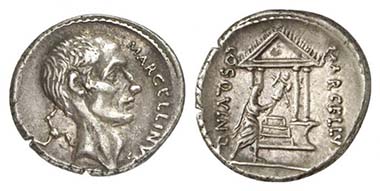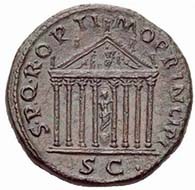Honos actually means nothing more than honor; it may seem remarkable to us that the Romans erected temples in honor of honor. To the Romans, however, that was nothing peculiar. To understand how Honor got herself a temple, it is necessary to familiarize ourselves with some basics of Roman religion.
Traianus. Sestertius. Rev. Temple for Honos. From auction UBS 78 (2008), 1605.
Originally, the Romans’ faith was that of a peasant tribe shivering at the incomprehensible acts of growing and dying. Growing of crop and fruitbearing of trees was so mysterious and, at the same time, so essential that the Romans made the individual processes in the farming calendar deities. There was a goddess blossoming, a goddess fruits, a god granary and a goddess growing. Strictly speaking, all those deities had no human form. They were neither man nor woman but something impersonal. A case in point is the cult for Vesta who was responsible for the hearth and who was worshipped in the hearth’s fire.
To conclude any act successfully it was of paramount importance to pray to all protectors involved in that act. If, for example, a priest prayed for a good harvest, he invocated the following gods when sacrificing: first ploughman, second ploughman, rut maker, sower, tillerman, harrower, weeder, hoer, chopper, harvester, granarer, and dispenser. They all had to be revered to ensure a safe harvest.
That concept of deities was fundamentally different to that of the Greeks. A Greek might well have prayed to Zeus for gaining honor, or to Ares, when he had that kind of honor in mind that went hand in hand with a successful military career, or to Athena, when he was more interested in scientific honor. A Roman, in contrast, worshipped honor itself, that honor he was bestowed on based on achievements. That was the reason why Honos was combined with Virtus, that deity which received sacrifices in the context of virtue. Honos and Virtus necessarily were a pair of gods since they were closely linked in every-day life, too. Virtus, hence all abilities and virtues a man (= Lat. vir) could possess, led to Honos, i.e. the honor and reputation such a man deserved.
Roman Republic. Denarius of P. Cornelius Lentulus Marcellinus, 50. Head of M. Claudius Marcellus r. Rev. Marcellus carrying the trophy to the temple. Cr. 439/1. From auction Künker 174 (2010), 551.
For that reason M. Claudius Marcellus pledged in 222 B. C. to build a temple in honor of these two deities. When fighting the Gauls, he had performed the biggest accomplishment possible and therefore was granted an extraordinary honor: in a fight man to man he had defeated the leader of hostile Gauls. That truly was a hero’s deed which the Romans honored by allowing Marcellus to personally dedicate the booty he took after the fight, the weapons of the enemy leader, in the temple of Jupiter. In 208, Marcellus intended to thank the gods and honor his vow but – to save expenditures – he tried to dedicate the existing Honos temple to both gods instead. That temple had been built in 234 by Q. Fabius Maximus Verrucosus after his victory over the Ligurians. Marcellus, however, wasn’t lucky. The senate felt that this way out of the vow was all too cheap. Hence, the victorious commander simply added a new cella for Virtus to the old one for Honos. In 205, that temple was inaugurated by his son. Vespasian had the building restored during his reign.
There is some indication that the temple shown on our coin is the very one for Honos. The statue inside the building, the die cutter has moved to the façade to make the identification easier, depicts a man with a drapery around the hips. In the right hand he is holding a scepter, in the left one a cornucopia. Similar depictions on other coins bear the explicit reference to Honos. But does this coin really allow a reconstruction of the temple’s layout?
Coins are no photographs. Roman die cutters had no desire to show a temple down to the tiniest detail. They rather showed what they regarded important. Something important was, for instance, when the temple was dedicated, hence the owner had to be clearly visible. Often, but not always, his depiction was integrated into the façade, sometimes in the shape of a cult statue. In fact, the god of course stayed in the interior of the cella, hidden from sight. It was absolutely of no relevance, however, how many columns a temple had, to the result that there are many depictions are known of one and the same temple differing in such quantifiable details. The building’s decoration with figures and reliefs was only relevant when the die cutter regarded it important in the context of his coin’s message. Because of that we are faced with depictions which show in minute detail the figural decoration of a building, whereas on others that decoration is only indicated by some lines.
Why, then, do we find the temple of the two deities, Honos and Virtus, on this Trajan coin and why is only one of them shown, i.e. Honos and not Virtus? After all, neither Honos nor Virtus ranged among the most important Roman deities. To understand that, we have to look at the inscription of the coin: SPQR OPTIMO PRINCIPI – The senate and the Roman people to the highest prince. Thus, an honor was involved; senate and people of Rome had bestowed the title “highest prince” to Trajan. Well, the honor is obvious, like the statues of Honos on the coin’s reverse, but the condition for that honor were the countless achievements of Trajan, his Virtus. And just like Virtus belonged to Honos in the temple, these achievements were the true reason for Trajan’s honor, which the best of all principles, however – and this is the hidden message of this coin –, out of modesty really didn’t want to hear.








